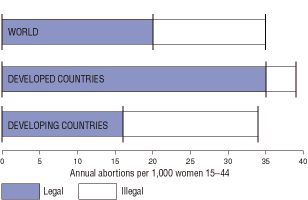WARNING!! The information and photographs contained in this guide are explicit and may be disturbing to some viewers. For those viewers under 18, and many older folk as well, afraidtoask.com strongly encourages you to discuss this guide and your questions with your parent, guardian, or trusted adult. Please review our user agreement and medical disclaimer before going any further. IN NO WAY SHOULD AFRAIDTOASK.COM’S SITE OR ONLINE GUIDES BE CONSIDERED AS OFFERING MEDICAL ADVICE!

Abortion is a controversial and sensitive topic. We believe that the following honest discussion will help answer questions and clarify misconceptions about abortion. As you read this guide, please keep in mind that our perspective is purely medical ““ not political. Abortion is a subject wrought with political and religious controversy. This guide in no way aims to be political in its discussion, but it will briefly outline the debate. Abortion is presented here as one of three options a woman has when she experiences an unplanned pregnancy: she can have the baby, put the baby up for adoption, or terminate the pregnancy with an abortion. Abortion is a term that embraces a number of meanings. In its broadest sense, an abortion ends a pregnancy before birth. In more precise and legal language, abortion is the termination of pregnancy before viability. Viability refers to the ability of the fetus to live outside the woman’s uterus. Most experts agree that a fetus cannot survive apart from the womb prior to 20 weeks of gestation. To understand it more fully, we classify abortions into two general groups: spontaneous and induced. A spontaneous abortion is commonly known as a “miscarriage.” In comparison, induced abortion involves some sort of medical intervention or procedure. An induced abortion may be elective or it may be performed under medical advisement.Here are some definitions of terms used in this guide:
- Abortifacients – an agent or drug which causes abortion
- Cervix -“neck” or opening to the uterus or womb
- Ectopic ““ pregnancies that occur outside the uterus
- Embryo – the developing human organism from two weeks after conception to the eighth week
- Fetus – the developing human organism from nine weeks after conception to birth
- Gestation – describes pregnancy or the period of development from conception to birth
- POC – (Products Of Conception) this is a technical term that describes what is expelled from the uterus following an abortion. It may include an embryo or fetus, the placental tissue, and uterine lining.
- Trimester – a pregnancy is commonly divided into three periods of three months each called trimesters
- Uterus – pear shaped female reproductive organ in which the fetus develops, also called the “womb.”
INDUCED ABORTION
Induced abortion is the voluntary termination of pregnancy. Abortion first became legal in the United States in 1973. Depending on the state, termination of pregnancy can be induced anytime up to the 20th week of gestation.
Today, legal abortion is one of the most frequently performed surgical procedures in America. Why? Statistics show that 50% of pregnancies in the U.S. are unintended. The majority of these end in abortion. Abortion may be induced for numerous reasons. A woman may opt to end pregnancy due to poverty, young age, or lack of social and emotional support. For most, the decision is extremely difficult, both psychologically and emotionally. Abortion after the first trimester is legal only when it is a therapeutic abortion. In this case, abortion is medically advised. Doctors advise ending pregnancy in certain situations. These include when there is a severe fetal abnormality incompatible with life or a serious risk to the woman’s health associated with continuing pregnancy. In general, there are two ways to induce abortion: medical and surgical. Medical abortion involves the use of medications or abortifacients to end pregnancy. It is usually done without entering the uterus. In contrast, surgical abortion ends pregnancy by emptying the uterus with special instruments.
MEDICAL ABORTION
The idea of using drugs to induce abortion is centuries old. Medically proven therapies, however, have come about only in the last 50 years. Essentially, drug induced abortions mimic a miscarriage. The pregnancy ends and the uterus empties. Thus, an important issue in medical abortion is how to manage pain, bleeding, and potential complications.

Medical abortions should always be performed under the care and supervision of trained and skilled medical personnel. Until recently, medical abortion was restricted to later gestational age. Today in the U.S., medical abortion provides an alternative to surgical abortion early in gestation. This is especially important for women who lack access to the full array of reproductive care services.
Different medicines may be used to induce an abortion, depending on the stage of the pregnancy. “Early” abortions take place in the first trimester; nearly 90% of all legal abortions in the U.S. are early, occurring within the first three months of gestation. In these cases, a one of two combinations of medicines is utilized: methotrexate/misoprostol or mifepristone (also known as RU-486).
Each treatment has a different effect on the body (see below) and both treatments can be taken up to 49 days after the last menstrual period begins. These regimens require several clinic or doctor’s office visits. Both are about 95% effective. In other words, approximately 1 in 20 women who undergo medical abortion will need to have a surgical abortion because the medication was not effective.
Methotrexate
Since 1953, methotrexate has been used in the US as an FDA approved treatment for certain types of cancer. Among other important medical uses, low-dose methotrexate has also been used for treating ectopic (outside the uterus) pregnancies. It works by interfering with tissue growth, uterine implantation, and fetal development. Currently, clinicians prescribe methotrexate for early abortion. It is usually given in the form of an injection or shot. A few days later, a second drug misoprostol is given either orally or as a vaginal suppository. Misoprostol is a prostaglandin, a naturally occurring substance. It causes the uterus to contract, emptying it of the lining and fertilized egg, and thereby ending the pregnancy. With methotrexate, 80-85% of women will abort within 2 weeks. Some may take longer and require more misoprostol.
Mifepristone
Also known as RU-486, mifepristone was first licensed as an abortifacient in France in 1988. Since then, it has been used by millions of women in Europe and China. It has been legally available in the U.S. since 2000. Mifepristone works by blocking the hormone progesterone. Without this essential hormone, the lining of the uterus breaks down, the cervix softens, and bleeding occurs. As with methotrexate, enough prostaglandin is given to help the uterus contract and expel its contents. With mifepristone, 95-97% of women will abort within two weeks.
SAFETY & COMPLICATIONS
Physical Effects
With medical abortion, the most common side effects come from misoprostol. Misoprostol is the medication taken after either methotrexate or mifepristone. It causes the uterus to contract and empty. Side effects may include headache and nausea, vomiting and diarrhea, strong cramps and heavy bleeding. The amount of bleeding after medical abortion is greater than after surgical abortion. Bleeding lasts from 4-40 days. In most cases, however, bleeding stops after 10 days. Some women require mild painkillers.
During surgical abortion, most women feel pain similar to menstrual cramps. Others experience greater discomfort despite the use of local painkillers. After the procedure, a woman may continue to have cramps and some bleeding. Most, however, are able to return to work and normal activities the next day.
Emotional Effects

Women end pregnancy for a variety of reasons. After abortion, many women describe feeling relief. Often there may be feelings of guilt, sadness, or loss as well. Mixed emotions are common. In fact, 70% of women who undergo abortion disclose a desire to have children sometime in the future. In addition, the circumstances that led to the decision to abort still may cause distress.
Despite all this, fewer than 20% of women report depressive symptoms immediately following an abortion. Most report that these are mild and transient in nature. Depressed mood may also be in part, biologically based. Ending pregnancy causes an abrupt change and drop in hormone levels. After thoughtful investigation, the American Psychological Association has concluded that there is no scientific evidence or support for severe psychological trauma induced by abortion.
Procedure Safety
The earlier an abortion is performed, the less complicated and safer it tends to be. Less than 1% of women who undergo legal abortion have a serious complication, but complication rates do increase with the length of pregnancy. Most complications occur within a few days after the abortion. Others can occur during the procedure or much later.
Overall, abortion has a low mortality rate. Currently, there is less than one death for every 100,000 procedures at every stage of gestation. In the first 20 weeks, getting an abortion is actually much safer than giving birth. In fact, the risk of death associated with childbirth is up to 10 times as high as that associated with abortion. The leading cause of death associated with induced abortion is anesthetic complications. This is followed by hemorrhage, embolism, and infection.
In addition to the length of pregnancy, there are a variety of other factors that can affect the rate of complications. These are skill and training of provider, type of anesthesia, woman’s overall health, and the abortion method used. Complications from abortion include:
Infection: Infection occurs in less than 3% of surgical abortions. Induction terminations have been associated with a slightly greater risk of 5-6%. This may be due to retained pregnancy tissue left in the uterus. Antibiotics given before the procedure can help reduce the risk. Signs of infection include chills or fever of 100.5F or higher, bad cramping, excessive bleeding, and/or vaginal discharge with a foul odor. With prompt identification and antibiotic treatment, the infection usually clears up without need for further intervention. If left untreated, infection can lead to serious illness, sterility, and even death.
Retained tissue: An incomplete abortion occurs when tissue from pregnancy remains in the uterus. This occurs in about 1-2% of all cases. Retained tissue can become infected. Signs of incomplete abortion include bleeding that is very heavy, lasts more than three weeks, or involves passage of large blood clots. Strong cramps or continued signs of pregnancy (sore breasts, nausea, etc.) after one week also indicate retained tissue. Treatment may include drugs to stimulate the uterus to contract and empty, or tissue removal by aspiration.
Hemorrhage: The risk of hemorrhage or excessive bleeding from the uterus is 1-2%. This can be caused by a number of factors. The most common cause is the failure of the uterus to contract. This is more likely to occur in second trimester abortions. Other reasons for very heavy bleeding are retained tissue or perforation. Treatment may include medication to stimulate the uterus to contract, surgical abortion, or surgery. Blood transfusions are required in rare cases.
Hematometra: Hematometra is when blood or blood clots accumulate in the uterus. This happens in up to 1% of abortions. It occurs when the uterus does not contract properly or when a blood clot blocks the cervix. Signs include decreased vaginal bleeding and a swollen, tender uterus. Worsening pain, cramping, and nausea are sometimes associated. Clots need to be removed by repeat aspiration or curettage.
Uterine Perforation: A perforation is a puncture or tear in the wall of an organ. There is a less than 0.5% risk that an instrument will go through the uterine wall during surgical abortion. Serious consequences include hemorrhage or damage to other organs such as the bowel. Many perforations heal by themselves. Few require surgical repair, or very rarely, hysterectomy. A higher risk of perforation is associated with multiparity (many deliveries), advanced gestational age, and operator inexperience. By relaxing the uterine muscles, and thus making them more vulnerable to penetration, general anesthesia is also associated with a higher risk of perforation.
Cervical Laceration: A cut or tear in the cervix occurs in less than 1% of cases. As with uterine perforations, cervical lacerations generally self-heal. Stitches are not usually required. Cervical tears are also more likely to occur with the use of general anesthesia for the same reasons that uterine perforation is more frequent. Therefore, sedation with local anesthesia is usually used for surgical abortion.
Continued Pregnancy: A continued pregnancy after surgical abortion ““ sometimes called a missed abortion ““ happens in less than 0.5% of abortions. It can occur in very early abortions (less than six weeks after the last menstrual period) or when there is a multiple pregnancy (twins, triplets, etc.). In this case, abortion will have to be repeated.
Possible effects on Future Pregnancies: Having an abortion does not necessarily lower the likelihood of having a healthy baby in the future. More specifically, uncomplicated legal abortion does not increase the risk of infertility, miscarriage, or ectopic (tubal) pregnancy. When a woman has Rh-type blood, medicine is given after an abortion to protect future pregnancies. There is limited study on the effect of multiple abortions.
SURGICAL VS. MEDICAL

Advantages of surgical abortion are that the procedure may be completed in one session; return to normal activities is usually the next day; risk of incomplete abortion is <1%; and continued pregnancy is rare. Disadvantages to surgical abortion are that it requires local or general anesthesia, the procedure depends on a physically skilled physician, and there is always a risk of cervical and uterine injury. Services can be obtained at clinics at a cost of $200-500, while hospitals tend to be more expensive.
In comparison, medical abortion does not involve risks associated with surgical instruments and anesthesia. Medical abortion can be performed very early in pregnancy and the outcome does not depend on a physician’s manual skill. The process is also more private. In fact, many women feel a greater sense of control.
The downside of medical abortion is that it can only be done up to seven weeks gestation in the U.S. ““ and up to nine weeks in some other countries. It involves pain and bleeding as in a miscarriage. Up to 1% of medical abortion result in continued pregnancy, requiring Dilation & Evacuation (D & C), while another 4% result in incomplete abortion, requiring surgical abortion as well. Currently, no long-term follow-up studies exist.
The medications methotrexate and misoprostol alone cost about $30. However, with the required 2-3 office visits, testing, and exams, medical abortion often ends up costing about the same as a surgical abortion.
LEGAL ASPECTS
Abortion Law in the United States

Prior to 1973, abortion except to save a woman’s life was banned in almost two-thirds of the U.S. In the remaining states, few additional exceptions were allowed. Illegal abortions at this time had high morbidity (sickness) and mortality (death) rates. Those that performed the procedure were often neither trained nor skilled and many were not licensed physicians. In addition, equipment and conditions were often unsanitary. Poor women were disproportionately affected. Wealthier women could pay higher fees or leave the country to have safe, legal abortions.
Roe versus Wade was decided in January 1973. In this landmark ruling, the Supreme Court invalidated restrictive abortion laws across the nation. However, abortion did not become an absolute right. Roe v. Wade does not provide “abortion on demand”. It does not allow for women to terminate pregnancy for any reason at any time throughout her pregnancy. Rather, an important balance was struck between a woman’s right to choose and the state’s interest in protecting a potential life.
This balance hinges on fetal viability””when a fetus is able to survive separate from the uterus””which is generally accepted at 20 weeks gestation. The Court ruled that until fetal viability, the woman has the right to choose abortion. After, each state may impose limitations as long as exceptions to protect the life and health of the woman are maintained.
Teenagers and Abortion Law
Laws requiring parental consent or notification before a minor may obtain an abortion are highly contested. Currently, 42 states have such laws on the books. Of these, 30 states have these laws in effect. In these states, teenagers who cannot obtain the consent of at least one parent must either travel out of state or obtain approval from a judge in order to legally end a pregnancy.
According to a process called “judicial bypass,” the pregnant adolescent must go before a judge, explain her situation, and rely on the judge’s decision. Defenders of mandatory parental consent believe that teenagers in such a situation cannot make competent decisions and therefore need adult guidance.
Opponents, however, point out that the result of parental notification and judicial bypass is the opposite of what was intended. Rather than promoting family communication, the law increases the risk of harm to the adolescent by delaying access to appropriate medical care.
Timely medial care is especially important for pregnant teens because of the hefty medical, personal, and social consequences of adolescent childbearing. In addition, the later an abortion occurs in pregnancy, the greater the risk of complications. A number of health professional organizations, including the American Medical Association, the American Academy of Pediatrics, the American College of Obstetricians and Gynecologists, have reached a consensus. They assert that minors should not be compelled to involve parents in the decision to obtain abortions.
RESOURCES

Abortion is the termination of pregnancy before birth. If it occurs spontaneously, it is commonly referred to as a miscarriage. In contrast, induced abortions require some sort of intervention. A woman either voluntarily opts to end an unwanted pregnancy or is advised to do so by doctors for health reasons. Abortions may be induced by drugs called abortifacients or done with the use of surgical instruments. Since the legalization of abortion in the US, abortion is now one of the most common and safest surgical procedures.
Yet abortion is a highly charged and emotional issue that has divided our society.

On one side are those who believe a woman has a right to make her own personal decision about whether abortion is an appropriate option based on her current situation. This is known as the “Pro-Choice” position. On the other end of the spectrum are those who believe that a gestating fetus should be protected as any other human life. This is known as the “Pro-Life” position. Often approaching the issue from a religious perspective, pro-lifers believe they represent the interests of the unborn child.
During the difficult process of deciding how to address an unexpected and/or unwanted pregnancy, it is important that a woman receive education and counseling on all safe and available options. In seeking information, guidance, and support, one must beware of any individual or group who give partial or false information, use tactics of intimidation, coercion, or guilt, and are not supervised by physicians, nurse practitioners, or other licensed medical personnel.
Listed below are some links to some of the more main-stream pro-choice and pro-life sites, as well as some recommended further readings.
Pro-Choice Organizations
- Planned Parenthood Federation of America
- National Organization of Women (NOW)
- National Abortion Rights Action League (NARAL)
- Catholics For Free-Choice
Pro-Life Organizations
SPONTANEOUS ABORTION
In medical language, spontaneous abortion is defined as the “expulsion of the products of conception without medical or mechanical intervention”. In lay terms, it is known as miscarriage. How frequently this occurs is unknown. That is because most women who experience spontaneous abortion do so very early in pregnancy. Often they are without symptoms and therefore unaware of being pregnant in the first place, and thus the subsequent miscarriage. Among recognized pregnancies, the rate of spontaneous abortion or “miscarriage” is said to be about 15%. Vaginal bleeding and uterine cramping are common symptoms preceding a spontaneous abortion. Certain characteristics can increase the risk of spontaneous abortion. These include advancing maternal or paternal age, higher number of gravidity (pregnancies), and a history of previous miscarriages. Chromosomal abnormalities are the most common known cause of first trimester loss. In addition to genetic mutations, recurrent spontaneous abortions can result from a number of other factors. These may include an incompetent cervix (abnormally prone to dilate), hormonal dysfunction, or cervix/uterus scars resulting from a sexually transmitted disease. Structural abnormalities can also cause consecutive miscarriages. A uterus that is markedly misshapen by a birth defect or multiple benign tumors will not sustain a growing fetus.